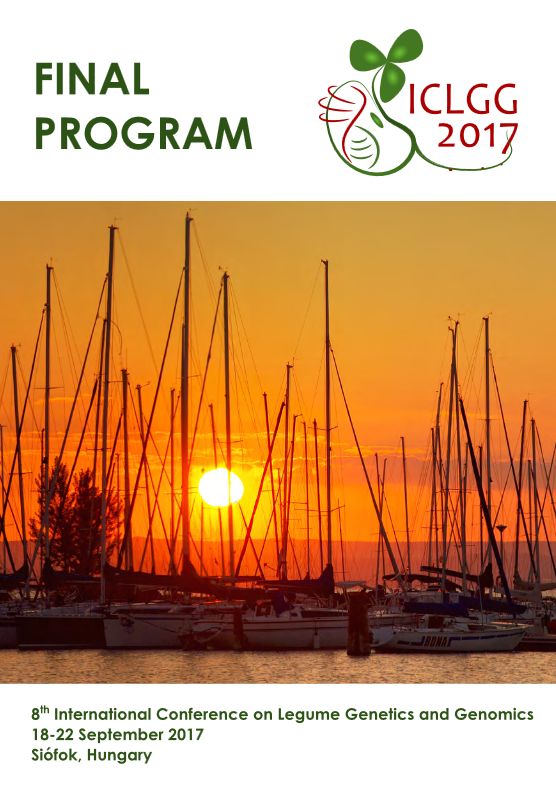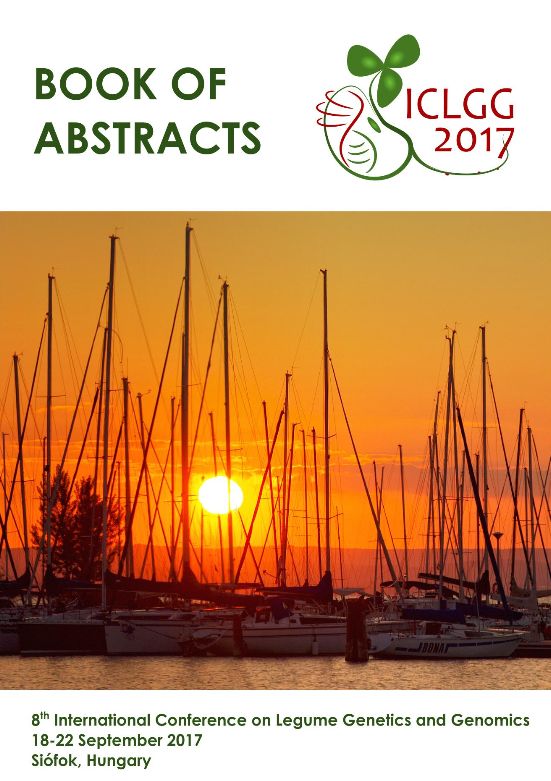 Print This Page Print This Page |
List of accepted posters ↓ |
 |
 |
18 September 2017 (Monday) |
|
| Arrival | |
| 12:30 | Registration |
| 12.00-14:00 | Lunch (for those who spent the night of Sept. 17 in Hotel Azur) |
| 15:00 | Opening ceremony
|
| 15:15 | Plenary session – General introduction Chair: T.H. Noel Ellis, György B. Kiss |
| 15:15-16:00 | Thomas R. Sinclair Physiological limits to legume genetic improvement |
| 16:00-16:45 | Alain Charcosset Statistical models for genetic improvement: towards genotyping guided global analysis of multiple families |
| 16:45-17:15 | Coffee break |
| 17:15-18:00 | Douglas R. Cook Harvesting crop wild relatives to improve chickpea cultivation in food-insecure countries |
| 18:00-18:45 | Stig Uggerhøj Andersen Exploiting systematic mutagenesis to identify targets for gene editing |
| 19:00 | Reception |
19 September 2017 (Tuesday) |
|
| 9:00 | Plenary session – Genomes Chair: Doug Cook, Stig Uggerhøj Andersen |
| 9:00-9:45 | David Bertioli Genetic behaviour and genome diversity in Arachis hypogaea |
| 9:45-10:30 | Judith Burstin The pea genome |
| 10:30-11:00 | Coffee break |
| 11:00-11:45 | Kirstin E. Bett Lentil genomes: Weird and wonderful wildlings |
| 11:45-12:00 | Timothy Close The cowpea genome sequence |
| 12:00-12:15 | Lars Kamphuis Development of genomic resources for narrow-leafed lupin |
| 12:15-12:30 | Abhimanyu Sarkar The Lathyrus sativus genome project |
| 12:30-14:00 | Lunch |
| 14:00 | Plenary session – Growth, form and N2 fixation Chair: Eva Kondorosi, Judith Burstin |
| 14:00-14:45 | Claire Domoney Genetic diversity and strategies for seed quality enhancement in pea |
| 14:45-15:30 | Cristina Ferrándiz The role of MADS-box genes in the evolution of fruit morphology and seed dispersal strategies |
| 15:30-16:00 | Coffee break |
| 16:00-16:45 | Attila Kereszt Nodule-specific plant peptides control intracellular accommodation of symbiotic bacteria |
| 16:45-17:00 | Jim Weller Comparative genetic analysis of flowering time adaptation in legumes |
| 17:00-17:15 | Mauren Jaudal MtSOC1a promotes flowering and elongation of the primary shoot axis in the reference legume Medicago truncatula |
| 17:15-17:30 | Colleen Friel Complex interactions in the rhizosphere: interplay between rhizobia, mycorrhizae, and the microbiome across Medicago genotypes |
| 17:30-17:45 | Georgina Hernandez Common bean microRNAs: unraveling novel players for the control of rhizobia nitrogen fixing symbiosis |
| 17:45 | Poster session #1 (odd numbers) Chairs: Eva Kondorosi, Judith Burstin |
| 17:45-18:20 | 5 min. poster flash talks
|
| 18:20 | Poster viewing (odd numbers) |
20 September 2017 (Wednesday) |
|
| 9:00 | Plenary session – Biotic stress Chair: Cristina Ferrándiz, Péter Kaló |
| 9:00-9:45 | Karam B. Singh Using Medicago truncatula to tackle disease issues in legumes with a focus on soil-borne fungal pathogens and insect pests |
| 9:45-10:30 | Marie-Laure Pilet-Nayel Quantitative resistance for durable management of Aphanomyces root rot of pea |
| 10:30-11:00 | Coffee break |
| 11:00-11:15 | Kiran Mysore Insertion mutagenesis of Medicago truncatula and its utilization to identify novel sources of resistance against Asian soybean rust |
| 11:15-11:30 | Valérie Geffroy Co-x, a non-canonical disease resistance gene of common bean to the fungus Colletotrichum lindemuthianum the agent of anthracnose |
| 11:30-11:45 | Jonathan Kreplak An RNAseq approach towards deciphering mechanisms involved in bruchid tolerance in faba bean |
| 11:45-12:00 | Juan M. Osorno Identifying genomic regions associated with disease resistance using GWAS: some real breeding examples in common bean |
| 12:00-12:15 | Nishant Bhanu Akhouri Assessment of genetic purity of inter-specific F1 hybrids involving V. radiata and V. umbellata |
| 12:15-12:30 | Pooja Bhatnagar-Mathur Successful aflatoxin mitigation in peanut using HIGS and transgenic approaches: technology and translation |
| 12:30-12:45 | David McKenzie Bird Cross-species eQTL mapping: A new genetic approach to reveal causal interactions between symbionts |
| 12:45-14:00 | Lunch |
| 14:00 | Business meeting (open for each attendee), then free afternoon |
| 18:00 | Poster session #2 (even numbers) Chair: Karine Gallardo, Attila Kereszt |
| 18:00-18:10 | 5 min. poster flash talks
|
| 18:10 | Poster viewing (even numbers) |
21 September 2017 (Thursday) |
|
| 9:00 | Plenary session – Abiotic stress Chair: Thomas Sinclair, Richard Thompson |
| 9:00-9:45 | Marion Prudent Drought response of nodulated roots in pea: from ecophysiological to transcriptomic analyses |
| 9:45-10:30 | Nijat Imin The yin and yang of nodulation: regulatory peptides that positively and negatively regulate root and nodule development in response to nitrogen availability |
| 10:30-11:00 | Coffee break |
| 11:00-11:15 | Shahal Abbo Drought response and genetic diversity in Pisum fulvum, a wild relative of domesticated pea |
| 11:15-11:30 | Charlotte Henriet The interplay between sulfur nutrition and the drought response in pea: a focus on seed development and composition |
| 11:30-11:45 | Jens Berger Building the base: widening the genetic & adaptive diversity of chickpea |
| 12:00-13:30 | Lunch |
| 13:30 | Plenary session – Legumes in the real world Chair: David Bertioli, Alain Charcosset |
| 13:30-14:15 | Maria Monteros Development of the alfalfa breeder’s toolbox: a resource for genomic, genetic and germplasm resources for alfalfa improvement |
| 14:15-15:00 | Karine Gallardo Recent advances in the regulation of seed protein composition in legumes: from genome-wide studies to new seed protein profiles |
| 15:00-15:30 | Coffee break |
| 15:30-16:00 | Endalkachew Wolde-meskel Sustainable intensification of grain legumes with smallholders in Africa through nitrogen fixation: highlights from the N2Africa project |
| 16:00-16:30 | Shoba Sivasankar (talk presented by Noel Ellis) The CGIAR research program on grain legumes and the International Year of Pulses |
| 16:30-16:45 | Roberto Papa Bean Adapt: the genomics of adaptation during crop expansion of common bean |
| 16:45-17:00 | Donal O’Sullivan Gene identification in faba bean – to synteny and beyond |
| 17:00-17:15 | Parwinder Kaur TrifoliGATE subterranean clover genomic resources: building a comprehensive user-friendly platform for future forage legume breeding |
| 17:15-17:30 | Samuel Hokin A collection of online resources for legume research |
| 17:30 | Closing of the conference |
| 18:30 | Banquet |
22 September 2017 (Friday) |
|
| Departure | |
The 15 min. talks and the 5 min. poster flash talks will be selected based on Abstracts submitted. Selected speakers will be informed.
List of accepted posters
P-01
Mohamed Lazali
Approaches for enhancement of phosphorus use efficiency of chickpea (Cicer arietinum L.) under limiting phosphorus conditions
P-02
Derya Yucel
Developing drought and heat stress tolerant chickpea genotypes
P-03
Márcia Carvalho
Evaluation of drought stress responses in cowpea genotypes
P-04
Judith Burstin
PeaMUST (2012-2019) – Pea Multi-Stress adaptation and biological regulations for yield improvement and stability
P-05
Weronika Czarnocka
Global analysis and comparison of transcriptomic changes in Medicago truncatula and Lotus japonicus root nodules during drought stress
P-06
Srinivasan Samineni
Marker assisted breed chickpea lines showed superior performance in multilocation testing in India
P-07
Omar Idrissi
Molecular diversity and quantitative trait loci related to drought tolerance in lentil (Lens culinaris Medik., Fabaceae)
P-08
Gordana Petrović
Osmotic stress tolerance in the early vegetative stages of field pea at the molecular level
P-09
Min Young Yoon
QTL identification for UV-B resistance traits in soybean using genotype-by-sequencing
P-10
Patricia Castro Lopez
TEMPRANILLO as a good candidate gene for flowering time in chickpea
P-11
Gholam Reza Zamani
The investigation of silicon effects on yield and growth of chickpea, under salinity stress
P-12
Karl Pauls
Genomic approaches to identifying bacterial and plant genes involved in pathogenicity and resistance to common bacterial blight in Phaseolus vulgaris
P-13
Katarzyna Hnatuszko-Konka
The effect of the presence of symbiotic Rhizobium on the effectivity of the Agrobacterium tumefaciens-mediated transformation of Phaseolus vulgaris
P-14
Marcin Nadzieja
Expanding genetic resources of Vicia faba – generation of a reference transcript set
P-15
Virginie Bourion
Comparative genome-wide-association mapping identifies common loci controlling root system architecture and resistance to Aphanomyces euteiches in pea
P-16
Ana Torres
Identificacion of new faba bean (Vicia faba L.) lines tolerant to Orobanche in the southern Spain
P-17
Kedar Adhikari
Identifying pathogen variability and virulence of Uromyces viciae-fabae on common cultivated legumes in Australia
P-18
Lars Kamphuis
Mining wild-chickpea (Cicer reticulatum and C. echinospermum) for adaptive traits to Australian growing conditions
P-19
Aladdin Hamwieh
Multi-environment QTL analyses for ascochyta blight resistance in a RIL population of chickpea (Cicer arientinum L.)
P-20
Julie Pasche
New SNP associated with common bacterial blight resistance in dry edible bean breeding lines
P-21
Cristina Caballo Linares
Identification of a gandidate gene for double podding in chickpea
P-22
Maria Pazos Navarro
Legume response to varied light quality and genetic control of flowering induction
P-23
Pyare Lal Johnson
Heterosis in relation to genetic divergence and hybridity in chickpea (Cicer arietinum L.) under rice based bropping system
P-24
Jungmin Ha
Identification of QTLs associated with number of branches in soybean
P-25
Yoon Min Young
Investigation on inflorescence architecture of mungbean associated with synchronous maturity in pods
P-26
Sergio Ochatt
Phytosulfokine-alpha, an enhancer of in vitro regeneration competence in recalcitrant legumes
P-27
Rafael Lozano
RNA-seq analysis uncovers common bean genes involved in pod maturation and dehiscence
P-28
Marta Santalla
An examination of QTL architecture underlying pod shattering resistance in common bean
P-29
Marcelino Perez de la Vega
Development of an interspecific linkage map and identification of genomic regions controlling agronomic traits in lentil
P-30
Özlem Cetin
DNA barcoding studies on two endemic species of Astragalus L. from Turkey using sequences of nrDNA ITS and cpDNA trnLiIntron and the trnL-trnF IGS
P-31
Mustafa Çelik
DNA barcoding study on Lotononis genistoides (Fenzl) Benth
P-32
Firouzeh Javadi
Ecological and evolutionary genetics of wild Cicer species
P-33
Jiangqi Wen
Finalizing the Tnt1 mutant population in Medicago truncatula
P-34
Sergio Ochatt
Flow cytometry measurements montribute to Pisum taxonomy
P-35
Nadia Benbrahim
Genetic diversity assessement of some Moroccan lentil landraces using electrophoresis (SDS-PAGE) of seed storage proteins
P-36
Márcia Carvalho
Genetic relationship of Vigna unguiculata spp. accessions based on cpSSR markers
P-37
Ambuj Jha
Genome wide association study to identify SNPs associated with folate profile in pea
P-38
Jose Die
Genome-wide identification and expression analysis of the auxin response factor gene family in Cicer arietinum
P-39
Rachit Saxena
Genomics advances for enhancing genetic gains in pigeonpea
P-40
Magdalena Kroc
Identification of genes involved in the alkaloid biosynthesis pathway in narrow-leafed lupin (Lupinus angustifolius L.) on the basis of transcriptome sequencing
P-41
Ping Wan
Identification of QTL and qualitative trait genes for agronomic traits in adzuki bean
P-42
Péter Kaló
Identification of the translocation breakpoint between chromosome 4 and 8 in the genomes of Medicago truncatula A17 and A20
P-43
Hyun-Ju Jang
Improvement of the mungbean reference genome assembly and QTL identification for synchronous pod maturity
P-44
Abdulkadir Aydogan
The first step for adaptation: width and distribution of the first flowering and podding dates in wild chickpeas
P-45
Petr Smýkal
Wild relatives of domesticated pea in the Mediterranean region and the Fertile Crescent will respond to global climate change
P-46
Fatema Bakro
Implementation of reverse genetics tools for improvement of pea cultivation in Poland
P-47
Candy Taylor
A series of fortunate events: unlocking flowering time variation in narrow-leafed lupin through an allelic series of mutation events at a major flowering time gene, LanFTc1
P-48
Seyedehmahsa Mousavi-Derazmahalleh
Plant and pathogen genomics: towards building resilience into narrow-leafed lupin crops
P-49
Sandra Rychel
Crosstalk between photoperiod and vernalization pathways – insight into genes involved in flowering induction in the narrow-leafed lupin
P-50
Teresa Millan
Development of chickpea near isogenic lines for QTLDF1 linked to flowering time
P-51
Barbara Pipan
Development of the common bean core collection referring to the Central and Southeastern European germplasm
P-52
Marina Ceran
Exploring the potential of genomic prediction in NS soybean breeding programs: preliminary results
P-53
Ana Torres
Genomic approaches to identify candidate genes controlling pod dehiscence in chickpea and faba bean
P-54
Rakesh Chahota
Genomics tools for the improvement of horsegram (Macrotyloma uniflorum): an orphan legume
P-55
Deepti Angra
Large scale SNP mining and validation in Vicia faba
P-56
Christine Lelandais-Briere
Non-coding RNAs: key actors of root developmental plasticity in Medicago truncatula
P-57
Venkata Sameer Kumar Chanda
Renaissance of pigeonpea breeding: via hybrid pigeonpea technology
P-58
Natalia Gutierrez Leiva
SNP genotyping of putative candidate genes involved in broomrape and Ascochyta fabae resistance in faba bean (Vicia faba L.)
P-59
Karen Frick
Sweetening the deal for narrow-leafed lupin (Lupinus angustifolius L.): genomic research to manage quinolizidine alkaloid accumulation in the grain
P-60
Petr Smýkal
The genomic and phenotypic evaluation of chromosome segment substitution lines of wild pea (P. fulvum) to widen the genetic diversity of pea crop
P-61
Roland Schafleitner
The International Mungbean Improvement Network – mobilizing the mungbean genetic diversity as a source for new traits for crop improvement
P-62
Rebecca Tacke
Towards a localization of the “vc-“gene which is responsible for low vicine and convicine content in seeds of faba bean (Vicia faba L.) and towards a low vicine and convicine winter faba bean cultivar
P-63
Mahendar Thudi
Untapping the potential of genome wide variations discovered through resequencing of germplasm lines for chickpea improvement
P-64
Richard Thompson
Characterization of the biosynthesis of saponins during seed development in peas (Pisum sativum) and faba beans (Vicia faba)
P-65
Oldřich Trněný
Comparative transcriptomic, anatomical and metabolic analysis of wild pea seed coat in relation to dormancy
P-67
Jose Jimenez-Lopez
Gene expression and localization of narrow-leafed lupin seed proteins evidence the functional interplay between conglutin protein families driving seed germination
P-68
Aijun Yang
Variation in seed coat colour and phytochemicals in Lablab purpureus in Australia
P-69
Petr Smýkal
Wild pea (Pisum sativum ssp. elatius) and Medicago truncatula seed dormancy as adaptation to environment
P-70
Jean-Francois Arrighi
Genetics and genomics of the Nod factor-independent Aeschynomene evenia to shed light on the evolution of the Rhizobium-legume symbiosis
P-71
Izabela Sańko-Sawczenko
Expression of PIN genes in root nodules of fabacean model plants
P-72
Hongyan Zhu
Host genetic control of symbiotic specificity in the legume-rhizobial interactions
P-73
Shawna Rowe
Investigating the role of ethylene in the sanctioning response of leguminous hosts to ineffective rhizobial partners
P-74
Alina Feinstein
Pan-genome assembly of population haplotypes provides a comprehensive solution to common obstacles in modern breeding
P-75
Myoyeon Kim
Transcriptomic profiling of genes involved in epicatechin biosynthesis in soybean
P-76
Sungwoo Lee
Dissection of genetic architectures of soybean protein, oil and amino acids
 Print This Page
Print This Page










